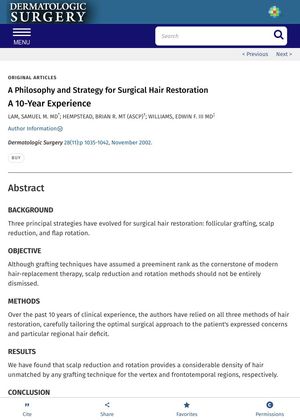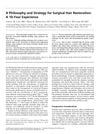A Philosophy and Strategy for Surgical Hair Restoration
November 2002
in “
Dermatologic Surgery
”
follicular grafting scalp reduction flap rotation incision line alopecia scarring hematoma flap necrosis midazolam sedation graft transplantation Tori-style scalpel donor hair crown baldness vertex frontotemporal regions follicular unit transplantation scalp reduction surgery flap surgery alopecia sedation hair grafting scalpel donor area bald spot top of the head front hairline

TLDR Scalp reduction gives the most natural result for significant crown baldness, despite potential complications, and a systematic approach to surgical hair restoration results in few complications and high graft survival.
In 2002, Samuel M. Lam, Brian R. Hempstead, and Edwin F. Williams III shared their 10-year experience with three main strategies for surgical hair restoration: follicular grafting, scalp reduction, and flap rotation. They found follicular grafting to be the most common method, but scalp reduction and rotation provided a higher density of hair for the vertex and frontotemporal regions. Despite potential complications like incision line alopecia, scarring, hematoma, and flap necrosis, they concluded that scalp reduction gave the most natural result for significant crown baldness. They also proposed a strategy involving intravenous midazolam sedation, graft transplantation, and the use of a Tori-style scalpel to harvest donor hair. The document emphasized a systematic approach to surgical hair restoration, with few complications and high graft viability. Temporary loss of non-transplanted hair was observed but was temporary, and donor-site incisions healed inconspicuously.





